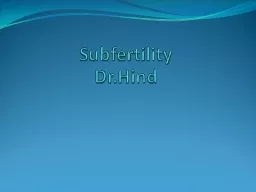

Semen analysis Volume155 ml Liquefaction time within 30 minutes Sperm concentration 15 million ml Sperm motility lt 50 progressive motility Sperm morphology 4normal forms ID: 777382
Download The PPT/PDF document "Subfertility Dr.Hind If the result of th..." is the property of its rightful owner. Permission is granted to download and print the materials on this web site for personal, non-commercial use only, and to display it on your personal computer provided you do not modify the materials and that you retain all copyright notices contained in the materials. By downloading content from our website, you accept the terms of this agreement.
Slide1
SubfertilityDr.Hind
Slide2If the result of the first semen analysis is abnormal, a repeat confirmatory test should be offered
Slide3Semen analysis:
Volume:1.5-5 ml
Liquefaction time :within 30 minutes
Sperm concentration :15 million \ml
Sperm motility :<50% progressive motilitySperm morphology : 4%normal forms• Lucocyte cells<1million\ml
Slide4Slide5Slide6Causes of male subfertility:
Disorder of spermatogenesis
Impaired sperm transport
Ejaculatory dysfunction
Immunological &infective factors
Slide7Slide8TREATMENT OF MALE INFERTILITY
Male fertility depends on sperm quality rather than the absolute number of sperm present. Men with
hypogonadotrophic
hypogonadism are treated with exogenous gonadotrophins and hCG to restore testicular volume and spermatogenesis.Hormonal therapy is, however, ineffective at restoring sperm production or function in men with idiopathic oligospermia
.
In these men intrauterine insemination with ovarian stimulation may be an appropriate treatment.
Slide9Alternatively,couples
may choose to proceed to IVF with
intracytoplasmic
sperm injection.
Men with obstructive azoospermia can be offered sperm aspiration followed by IVF with ICSI treatment. Although 25 per cent of men with abnormal sperm parameters have a varicocele, there is no evidence that surgical ligation improves fertility.
Slide10Assissted conception
Assisted conception techniques have, since their introduction in the late 1970s, enabled more than a million babies to be conceived.
These conceptions have depended on the development of
laboratory, clinical
and pharmaceutical advancements that have simplified and improved the treatment of subfertilityintrauterine insemination, IVF and ICSI are widely used throughout the world to assist conception.
Slide11Intrauterine insemination
Intrauterine insemination involves the placement of a sample of purified sperm in the uterus at the time of ovulation. It is most successful if it is combined with ovarian stimulation to produce up to three mature
follicles.
Close monitoring of the treatment is essential as there is a high risk of multiple pregnancy if treatment continues when more than three follicles have formed. It is used to treat
mild male factor subfertility as well as unexplained subfertility. Although the success rate varies between assisted conception units, approximately 10-15 per cent of couples manage to conceive by this method.
Slide12Slide13In the technique of gamete
intrafallopian
transfer (GIFT), a laparoscope is used to transfer the eggs and sperm to the
fimbrial
part of the Fallopian tube. This allows fertilization to occur in the natural location and has the advantage of requiring minimal laboratory facilities. However, GIFT has the disadvantage of requiring a general anaesthetic and laparoscopy. The treatment still requires controlled ovarian stimulation, but egg retrieval may be by a laparoscopic technique or by the more usual ultrasound-assisted
transvaginal
method.
Slide14ZIFTZygote
intrafallopian
transfer (ZIFT) is an infertility treatment where a blockage in the fallopian tubes are the cause. Egg cells are removed from a woman's ovaries, and in vitro fertilized. The resulting zygote is placed into the fallopian tube by the use of laparoscopy.
Slide15In Vitro Fertilization
Slide16Slide17A typical IVF-Embryo transfer cycle
Initial consultation
Pituitary down-regulation
Superovulation
ovarian stimulationOvulation trigger with hCG triggerOocyte collectionInsemination of oocytesEmbryo transfer
Luteal
support
Pregnancy test
Slide18Initial consultation
Initial consultation involves a detailed history and provides an opportunity to assess the cause of subfertility and the most appropriate treatment technique.
Prior to commencing IVF, a recent baseline FSH level, semen analysis and pelvic ultrasound are assessed.
Slide19Pituitary down-regulation
Pituitary down-regulation is essential to prevent a natural LH surge during follicular stimulation as this would result in follicular rupture prior to egg retrieval. Treatment with
GnRH
analogues, given by daily injection, implant or nasal spray, prevents the natural LH surge and is continued throughout the treatment cycle
Alternatively, GnRH antagonists can be administered during the mid- and late follicular phases of a super ovulation cycle to prevent the LH surge. A low serum oestradiol level « 100 u/L)
or thin endometrium on ultrasound scan are used to confirm down-regulation of the pituitary.
Slide20Ovarian stimulation
Ovarian stimulation is achieved by daily injections of
gonadotrophins
(either recombinant or urinary). The injections are continued for 11-14 days until the lead follicles are 18 mm in diameter on
transvaginal ultrasound scan.
Slide21Ovulation trigger with hCG
In the stage of ovulation trigger with HCG, HCG is used in place of LH to trigger ovulation. The oocytes are retrieved 34-38 hours after the injection.
Slide22Oocyte collection
Oocyte
collection is normally an outpatient procedure carried out under
transvaginal
ultrasound guidance with the woman under intravenous sedation.The follicular fluid is aspirated from each follicle using a controlled pressure vacuum pump Using a microscope, the embryologist identifies the oocytes removed in the follicular fluid and then transfers these to culture medium in an incubator.
Slide23Slide24During sperm preparation, the sperm sample is washed to remove seminal plasma, leukocytes and bacteria. A laboratory process that allows the sperm to mature and undergo capacitation is performed, and the motile sperm can then be selected for use in the insemination process.